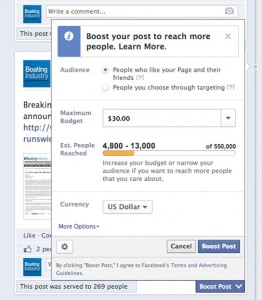Measuring social ROI

Tracking the success of social media efforts requires planning, analysis
You know you should be on social media. But how do you know if it’s working?
It’s a common refrain for companies large and small, inside and outside of the marine industry. Oftentimes, that’s because companies aren’t exactly sure what they are trying to accomplish.
One of the biggest mistake companies make when it comes to social media is going in without a plan, said Lauren de Vlaming, social media manager at Dominion Marine Media.
“Most people have a problem with measuring the success of social media because they haven’t identified their objectives,” she said. “They’re there because they know it’s the trendy place to be. They know it’s important to be there, but they’ve never sat down and said OK, this is what we want to use it to do.”
Setting goals
Your social media outreach is just like any other marketing effort. It doesn’t do any good without a set goal.
For example, most dealerships wouldn’t run a direct mail campaign, sending out hundreds or thousands of postcards, without a clear message. Whether it’s promoting an event, a special on winterization or increasing awareness of the company, there’s a set goal. The same rules apply to social media.

“Social is really a tool that you’re using, and that tool can do different things depending on how you use it,” de Vlaming said. “So once you clarify a goal, it’s pretty clear what you should be measuring.”
Using a social media campaign to promote a specific product – say a used boat you’ve had trouble moving – or event can be relatively easy to track because there is that specific call to action.
Most companies look to social media for brand building, but developing that message takes more refinement and planning. Every company has a brand – an image that customers have of them.
When working with its clients on brand building, ARI Network Services helps them define their unique value proposition – that thing that makes them stand out from the competition, said chief marketing officer Heather Blessington.
That brand could be excellent customer service, a reputation for quality service work, the low price leader or a bevy of other things, good or bad.
“I do believe everyone has one,” Blessington said. “There’s a reason people are coming to your dealership. There’s something there that’s unique.”
Social media’s effect can be difficult to measure when there’s not an immediate call to action. Still, by making the effort, companies can more reliably track the results.
“Sometimes dealers are their own worst enemies,” Blessington said. “They want to measure their success, but sometimes they don’t want to put in the effort that it’s going to take to get those analytics at their dealership.”
It requires the sales team to always be asking that question of “How did you hear about us?” and drilling down to discoveer the different methods. If the first answer is, “We saw you at the boat show,” find out if, for example, they also have been following you on Facebook.
“Everything digital is trackable. It’s trackable to the point of sale in the dealership and that’s where the dealer’s responsibility comes in,” Blessington said. “Unless at the register, through the salespeople … they’re saying how did you hear about us or how did you find this website or this boat and where did you find it” results can be difficult to measure.
If the goal is using a Facebook post to drive people to your website, that’s very easy to track by simply using Google Analytics (see sidebar).
Other useful tools include HootSuite, which de Vlaming recommends for its ease of use for not only posting across multiple platforms but also tracking the results. While there is a paid version available, the free version itself is pretty robust.
“It’s the best free platform that’s out there right now,” she said. “You can see who clicks on your links, measure things like how much traffic you’re driving. It’s a pretty incredible analytics suite for a free product.”
Besides Google Analytics, Blessington also recommends HubSpot, which has many of the same benefits of HootSuite.
Social advertising
As the 800-pound gorilla of social media, Facebook has been the biggest area of focus for most companies.
However, as the company continues to try to find ways to monetize its 1 billion-plus users it has become more difficult to get your message to customers. Facebook advertising, though, can be inexpensive and effective when done properly.
“Dealers who have success with Facebook advertising are very streamlined in what their goals are,” de Vlaming said. “They’re not just throwing money out into the abyss and hoping it somehow benefits them.”
Facebook has recently revamped its advertising suite to make it even easier to use and track success, guiding advertisers through the process, de Vlaming said.
“It’s set up so you don’t have to be a rocket scientist to figure out,” she said. “Facebook breaks it down and makes it really accessible for you, even for a dealer who doesn’t have a large marketing team to take care of it.”
While pure advertising may turn some users off, the use of promoted posts to put your message in front of more people can be successful, Blessington said.
“They are so affordable, so you can … put down a $35 spend to promote a particular post,” she said. “What we like about this, and what Facebook is finding people like about it, is that it is relevant content.”
With promoted posts being so inexpensive, Blessington recommends trying it out as part of a campaign, such as promoting an event. By targeting certain ZIP codes, or users that have “liked” certain brands or other dealers, you can easily hone in the right audience.
“Especially in an event scenario, that can be pretty effective,” she said. “People tend to be more open to something that’s local, something that’s in their interest category, versus just a flat out ad.”
Boosting a Facebook post
By Heather Blessington, ARI Network Services
 The fastest way to boost recent posts, is directly on your Facebook page:
The fastest way to boost recent posts, is directly on your Facebook page:
1. Go to any post you’ve recently created.
2. Click Boost Post at the bottom right of your post.
3. Choose your audience and budget based on how many people you want to reach. You can also click More Options to select the duration of your boost or change your payment method.
4. Click Boost Post.
While this method allows you to see how many people your post has the potential to reach, it doesn’t allow you to select the specific demographics of your key prospects. To take a more targeted approach, boost your Facebook post from your Facebook Advertising admin.
1. Go to the ads create tool and select Page Post Engagement.
2. Select the post you’d like to boost from the dropdown menu.
3. Scroll down the page to the Audience section to narrow in on the exact audience you’d like to target. Not only can you select your target’s region, gender and age, but you can actually target your prospects Interests. In this example we’ve used Boating and Fishing. On the right you’ll see a section called Audience Definition that will show you the exact size of your selected audience.
4. Once you’ve selected the audience demographics, scroll down to the Campaign and Ad Set section. Select a daily budget and designate a Schedule for your promotion.
5. In the Bidding and Pricing box, select Bid For Page Post Engagement.
6. Click the green Place Order button.
Shortly after boosting a Page post, you’ll be able to see its performance in ads manager and in the Posts tab of your Page Insights.




